Debating Corporate Giving Responsibilities in Fund Raising Strategies
VerifiedAdded on 2022/08/20
|7
|1176
|12
Essay
AI Summary
This essay delves into the debate surrounding corporate giving and its role in fund raising for non-profit organizations. It explores the arguments for and against considering charitable giving as a responsibility of corporate stakeholders. The essay examines the stakeholder model, which emphasizes the needs and pressures of various stakeholders, including shareholders, employees, and community groups. It discusses the advantages of corporate giving, such as enhanced community support and market development, as well as potential drawbacks like hindered organizational goal achievement and financial resource constraints. The essay concludes by highlighting the importance of proper planning and intention in corporate giving to maximize its positive impact. The essay uses several academic references to support the arguments and provide a comprehensive analysis of the subject.
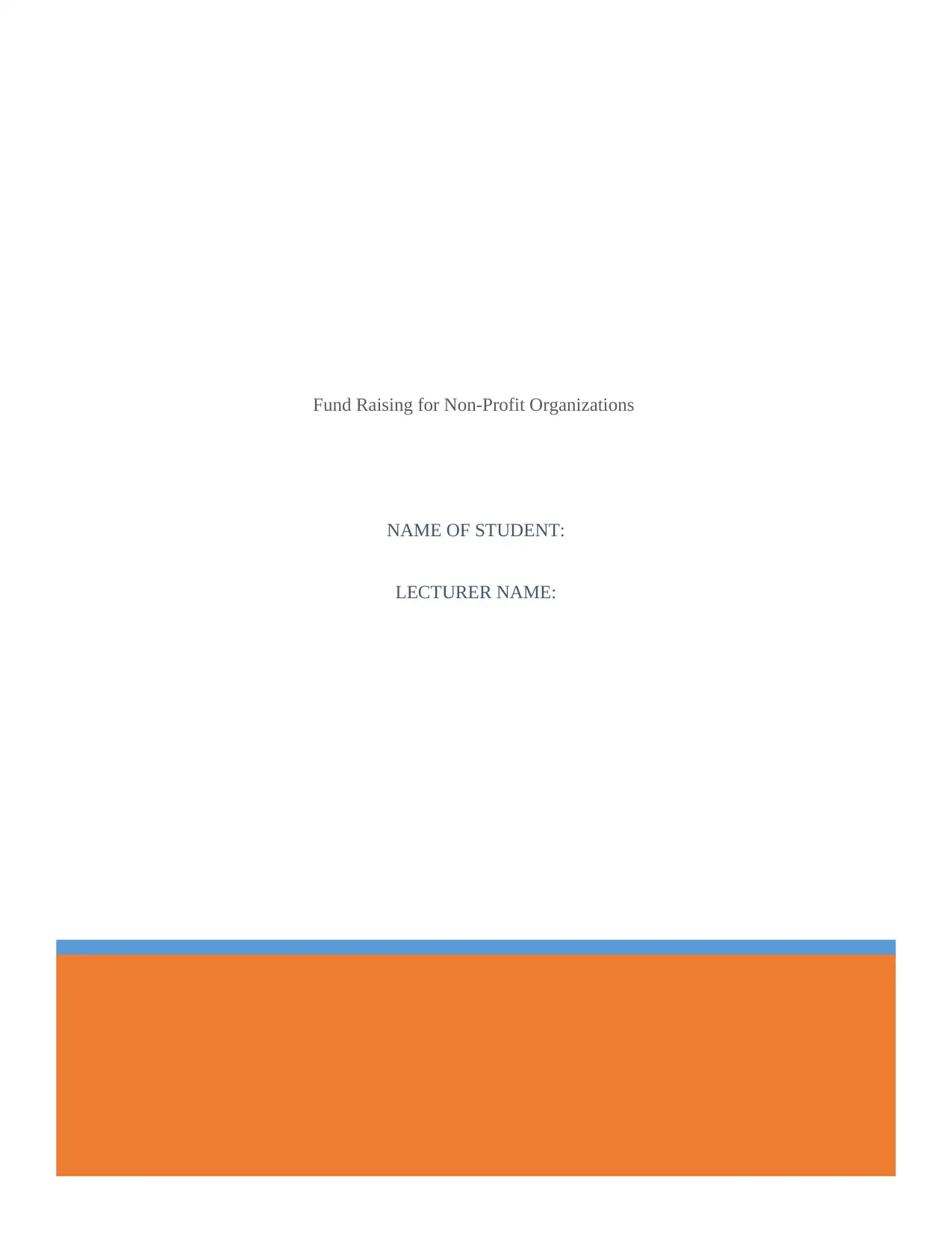
Fund Raising for Non-Profit Organizations
NAME OF STUDENT:
LECTURER NAME:
NAME OF STUDENT:
LECTURER NAME:
Paraphrase This Document
Need a fresh take? Get an instant paraphrase of this document with our AI Paraphraser
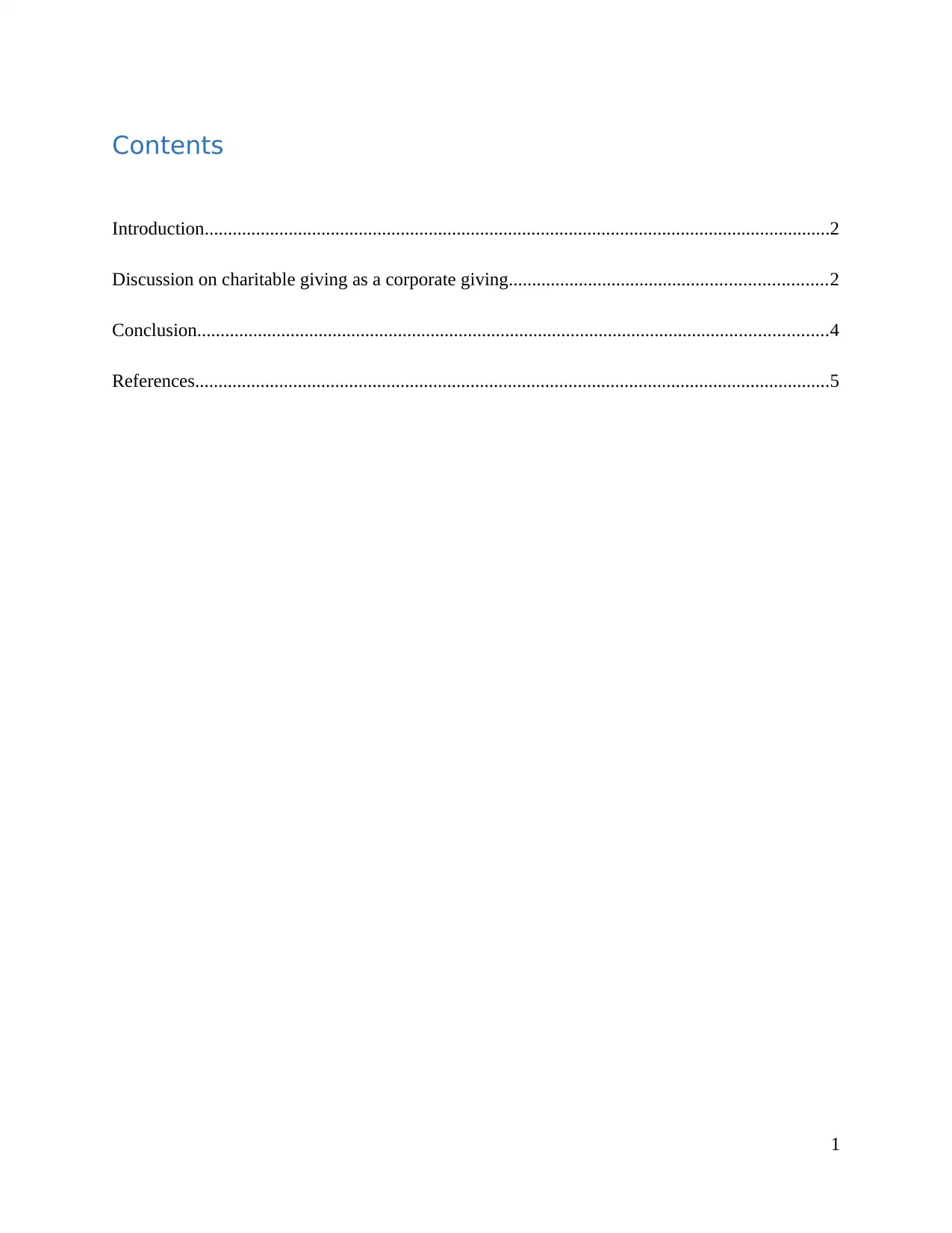
Contents
Introduction......................................................................................................................................2
Discussion on charitable giving as a corporate giving....................................................................2
Conclusion.......................................................................................................................................4
References........................................................................................................................................5
1
Introduction......................................................................................................................................2
Discussion on charitable giving as a corporate giving....................................................................2
Conclusion.......................................................................................................................................4
References........................................................................................................................................5
1
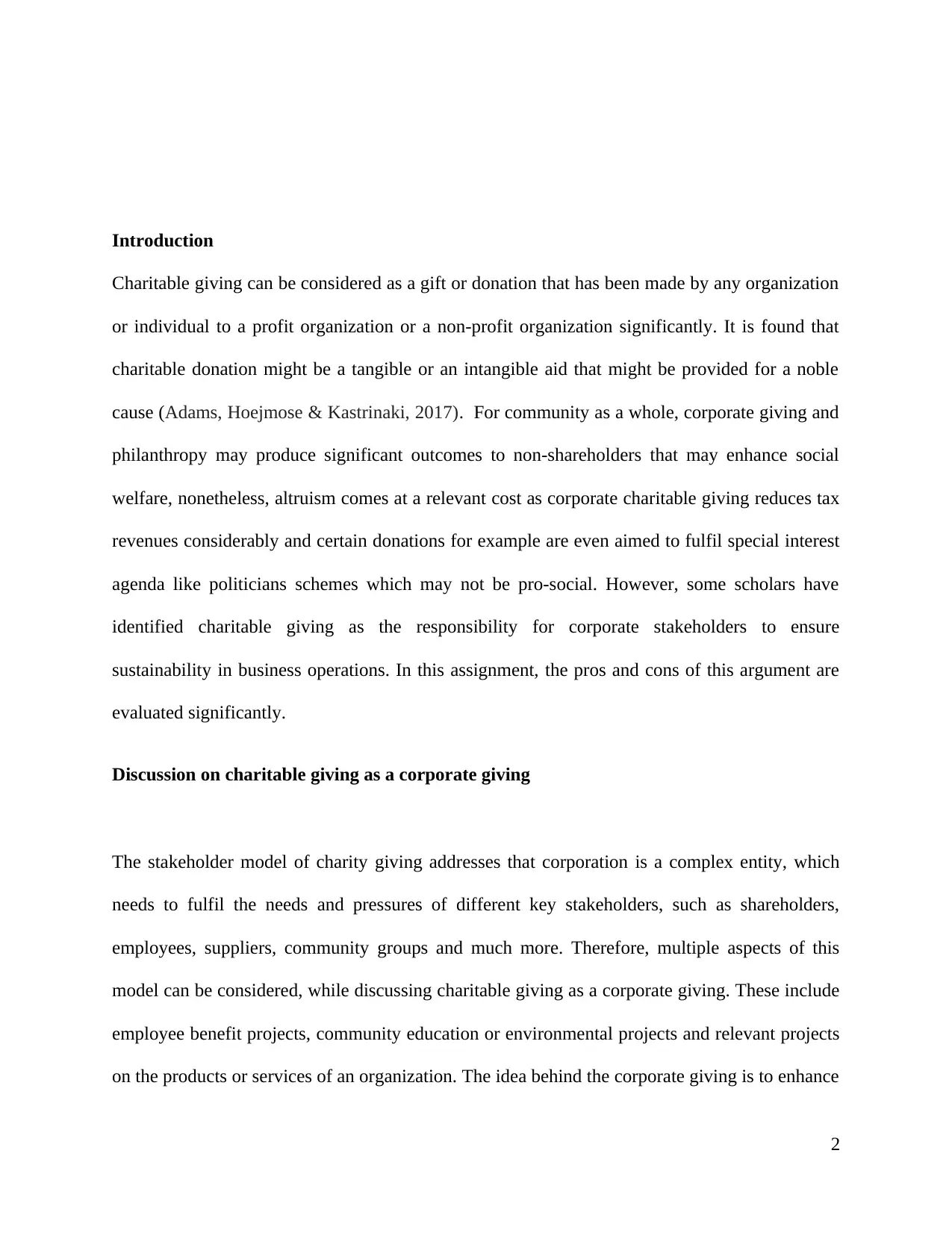
Introduction
Charitable giving can be considered as a gift or donation that has been made by any organization
or individual to a profit organization or a non-profit organization significantly. It is found that
charitable donation might be a tangible or an intangible aid that might be provided for a noble
cause (Adams, Hoejmose & Kastrinaki, 2017). For community as a whole, corporate giving and
philanthropy may produce significant outcomes to non-shareholders that may enhance social
welfare, nonetheless, altruism comes at a relevant cost as corporate charitable giving reduces tax
revenues considerably and certain donations for example are even aimed to fulfil special interest
agenda like politicians schemes which may not be pro-social. However, some scholars have
identified charitable giving as the responsibility for corporate stakeholders to ensure
sustainability in business operations. In this assignment, the pros and cons of this argument are
evaluated significantly.
Discussion on charitable giving as a corporate giving
The stakeholder model of charity giving addresses that corporation is a complex entity, which
needs to fulfil the needs and pressures of different key stakeholders, such as shareholders,
employees, suppliers, community groups and much more. Therefore, multiple aspects of this
model can be considered, while discussing charitable giving as a corporate giving. These include
employee benefit projects, community education or environmental projects and relevant projects
on the products or services of an organization. The idea behind the corporate giving is to enhance
2
Charitable giving can be considered as a gift or donation that has been made by any organization
or individual to a profit organization or a non-profit organization significantly. It is found that
charitable donation might be a tangible or an intangible aid that might be provided for a noble
cause (Adams, Hoejmose & Kastrinaki, 2017). For community as a whole, corporate giving and
philanthropy may produce significant outcomes to non-shareholders that may enhance social
welfare, nonetheless, altruism comes at a relevant cost as corporate charitable giving reduces tax
revenues considerably and certain donations for example are even aimed to fulfil special interest
agenda like politicians schemes which may not be pro-social. However, some scholars have
identified charitable giving as the responsibility for corporate stakeholders to ensure
sustainability in business operations. In this assignment, the pros and cons of this argument are
evaluated significantly.
Discussion on charitable giving as a corporate giving
The stakeholder model of charity giving addresses that corporation is a complex entity, which
needs to fulfil the needs and pressures of different key stakeholders, such as shareholders,
employees, suppliers, community groups and much more. Therefore, multiple aspects of this
model can be considered, while discussing charitable giving as a corporate giving. These include
employee benefit projects, community education or environmental projects and relevant projects
on the products or services of an organization. The idea behind the corporate giving is to enhance
2
⊘ This is a preview!⊘
Do you want full access?
Subscribe today to unlock all pages.

Trusted by 1+ million students worldwide
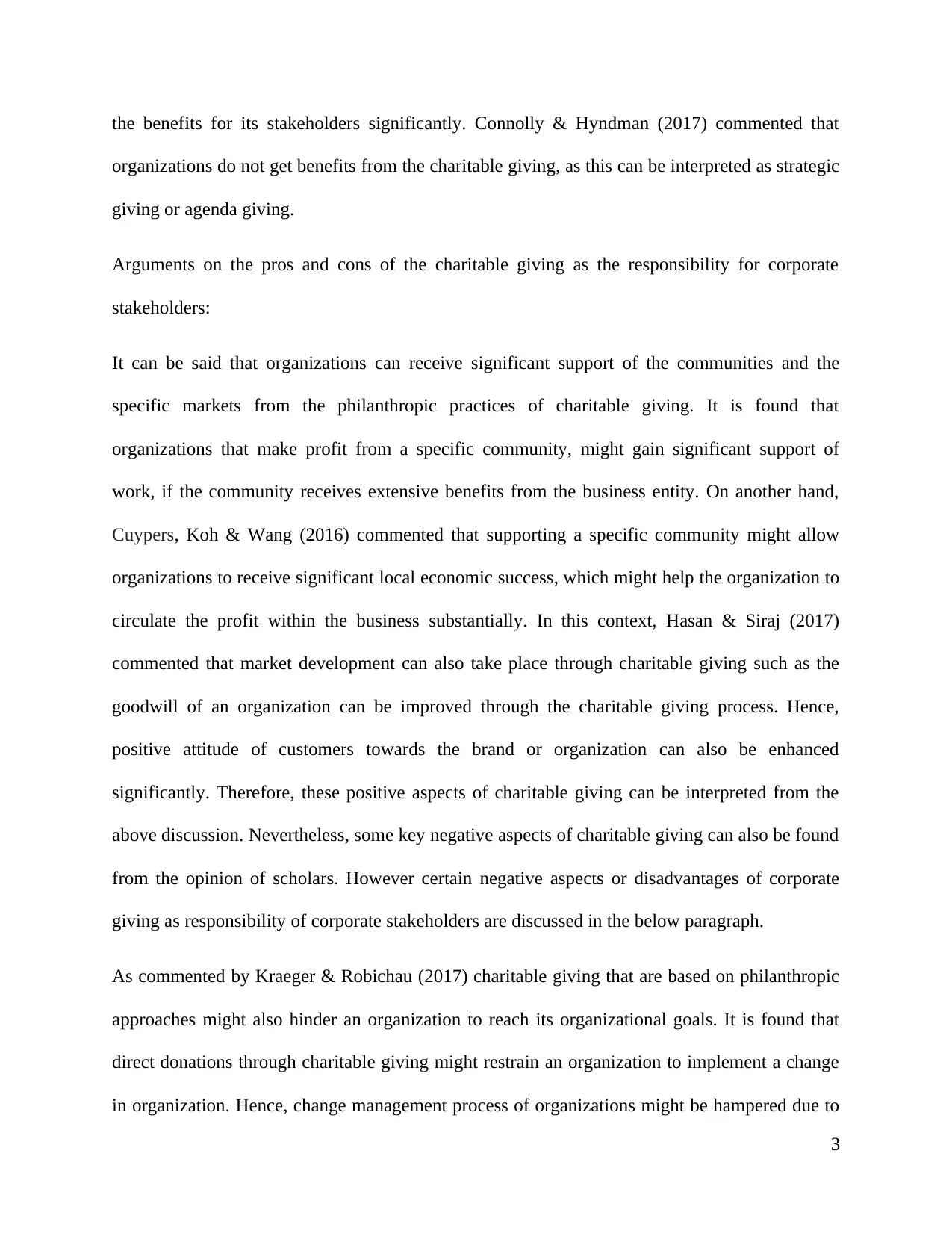
the benefits for its stakeholders significantly. Connolly & Hyndman (2017) commented that
organizations do not get benefits from the charitable giving, as this can be interpreted as strategic
giving or agenda giving.
Arguments on the pros and cons of the charitable giving as the responsibility for corporate
stakeholders:
It can be said that organizations can receive significant support of the communities and the
specific markets from the philanthropic practices of charitable giving. It is found that
organizations that make profit from a specific community, might gain significant support of
work, if the community receives extensive benefits from the business entity. On another hand,
Cuypers, Koh & Wang (2016) commented that supporting a specific community might allow
organizations to receive significant local economic success, which might help the organization to
circulate the profit within the business substantially. In this context, Hasan & Siraj (2017)
commented that market development can also take place through charitable giving such as the
goodwill of an organization can be improved through the charitable giving process. Hence,
positive attitude of customers towards the brand or organization can also be enhanced
significantly. Therefore, these positive aspects of charitable giving can be interpreted from the
above discussion. Nevertheless, some key negative aspects of charitable giving can also be found
from the opinion of scholars. However certain negative aspects or disadvantages of corporate
giving as responsibility of corporate stakeholders are discussed in the below paragraph.
As commented by Kraeger & Robichau (2017) charitable giving that are based on philanthropic
approaches might also hinder an organization to reach its organizational goals. It is found that
direct donations through charitable giving might restrain an organization to implement a change
in organization. Hence, change management process of organizations might be hampered due to
3
organizations do not get benefits from the charitable giving, as this can be interpreted as strategic
giving or agenda giving.
Arguments on the pros and cons of the charitable giving as the responsibility for corporate
stakeholders:
It can be said that organizations can receive significant support of the communities and the
specific markets from the philanthropic practices of charitable giving. It is found that
organizations that make profit from a specific community, might gain significant support of
work, if the community receives extensive benefits from the business entity. On another hand,
Cuypers, Koh & Wang (2016) commented that supporting a specific community might allow
organizations to receive significant local economic success, which might help the organization to
circulate the profit within the business substantially. In this context, Hasan & Siraj (2017)
commented that market development can also take place through charitable giving such as the
goodwill of an organization can be improved through the charitable giving process. Hence,
positive attitude of customers towards the brand or organization can also be enhanced
significantly. Therefore, these positive aspects of charitable giving can be interpreted from the
above discussion. Nevertheless, some key negative aspects of charitable giving can also be found
from the opinion of scholars. However certain negative aspects or disadvantages of corporate
giving as responsibility of corporate stakeholders are discussed in the below paragraph.
As commented by Kraeger & Robichau (2017) charitable giving that are based on philanthropic
approaches might also hinder an organization to reach its organizational goals. It is found that
direct donations through charitable giving might restrain an organization to implement a change
in organization. Hence, change management process of organizations might be hampered due to
3
Paraphrase This Document
Need a fresh take? Get an instant paraphrase of this document with our AI Paraphraser

the application of this process. Further, a donation to a nonprofit organization might also change
the objectives critically. Hence, if the nonprofit agency does not invest the received money in
community purpose, then the notion of charitable giving cannot be justified from a philanthropic
standpoint. In addition, Liu et al. (2019) argued that financial resource is another significant
aspect that organizations should focus prior to considering the charitable giving. It is identified
that conducting a charitable event might require huge amount of money and organizations should
develop teams before conducting any charitable event crucially. Besides this, some other aspects
should also be considered to maintain the process of the project. For instance, the marketing
process and budget allocation is also necessary to ensure that enough availability of financial
resources that might help a non-profit organization may smoothly flow through charitable giving
projects. Therefore, it can be justified that charitable giving is a responsibility for stakeholders
that needs to be accomplished with proper planning and good intention.
Conclusion
From the above discussion, it can be found that the stakeholder model of charity giving involves
the betterment of employees, shareholders and communities significantly, as organizations do
not receive direct benefits from the charitable giving process. Further, some advantages of
charitable giving are identified such as development of market and increased reputation of the
organization. Nevertheless, some setbacks of this process is also identified from the existing
literature. It can be concluded that improper planning might increase the scarcity of financial
resources that might hinder an organization to implement change management irrespective of
getting donations.
4
the objectives critically. Hence, if the nonprofit agency does not invest the received money in
community purpose, then the notion of charitable giving cannot be justified from a philanthropic
standpoint. In addition, Liu et al. (2019) argued that financial resource is another significant
aspect that organizations should focus prior to considering the charitable giving. It is identified
that conducting a charitable event might require huge amount of money and organizations should
develop teams before conducting any charitable event crucially. Besides this, some other aspects
should also be considered to maintain the process of the project. For instance, the marketing
process and budget allocation is also necessary to ensure that enough availability of financial
resources that might help a non-profit organization may smoothly flow through charitable giving
projects. Therefore, it can be justified that charitable giving is a responsibility for stakeholders
that needs to be accomplished with proper planning and good intention.
Conclusion
From the above discussion, it can be found that the stakeholder model of charity giving involves
the betterment of employees, shareholders and communities significantly, as organizations do
not receive direct benefits from the charitable giving process. Further, some advantages of
charitable giving are identified such as development of market and increased reputation of the
organization. Nevertheless, some setbacks of this process is also identified from the existing
literature. It can be concluded that improper planning might increase the scarcity of financial
resources that might hinder an organization to implement change management irrespective of
getting donations.
4
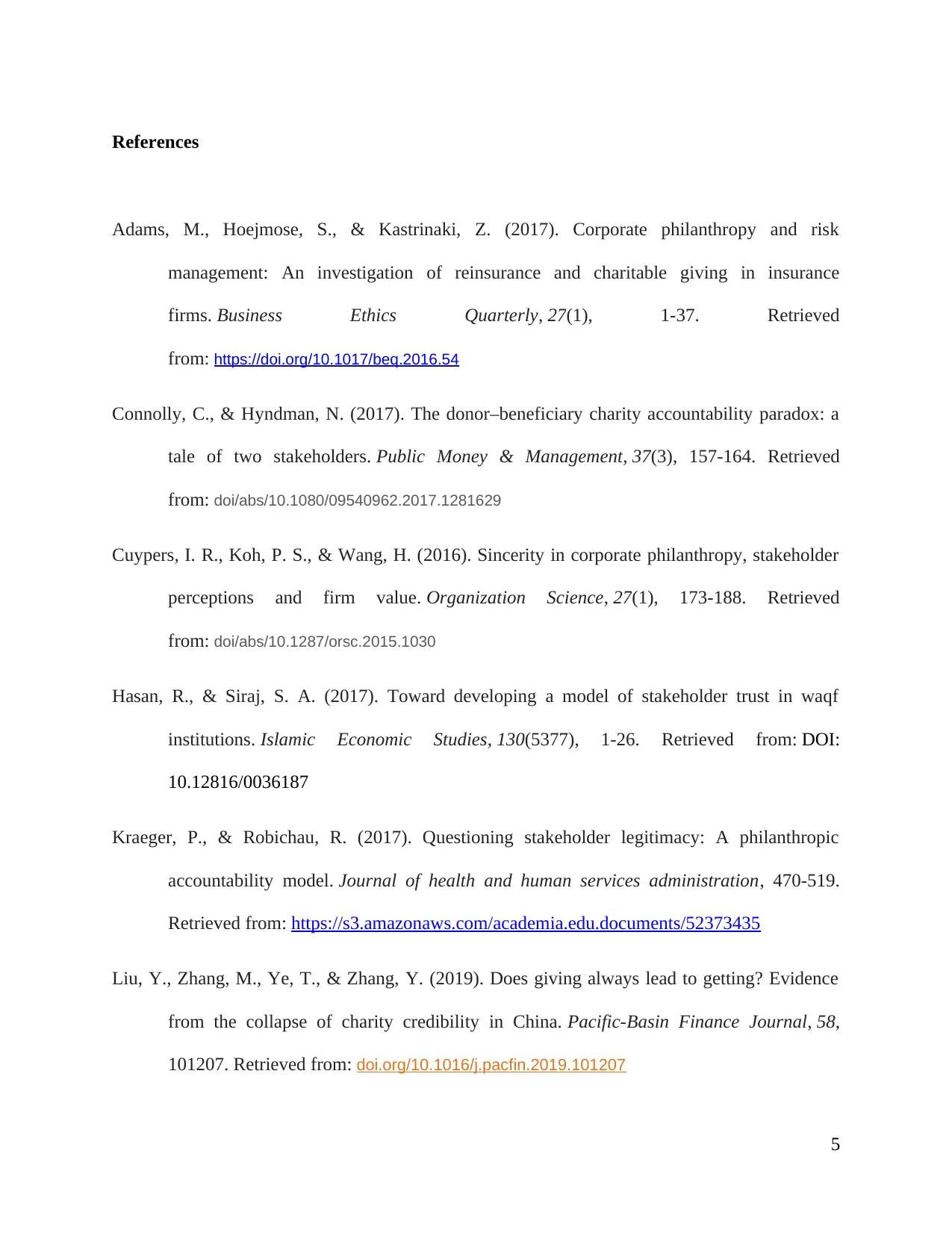
References
Adams, M., Hoejmose, S., & Kastrinaki, Z. (2017). Corporate philanthropy and risk
management: An investigation of reinsurance and charitable giving in insurance
firms. Business Ethics Quarterly, 27(1), 1-37. Retrieved
from: https://doi.org/10.1017/beq.2016.54
Connolly, C., & Hyndman, N. (2017). The donor–beneficiary charity accountability paradox: a
tale of two stakeholders. Public Money & Management, 37(3), 157-164. Retrieved
from: doi/abs/10.1080/09540962.2017.1281629
Cuypers, I. R., Koh, P. S., & Wang, H. (2016). Sincerity in corporate philanthropy, stakeholder
perceptions and firm value. Organization Science, 27(1), 173-188. Retrieved
from: doi/abs/10.1287/orsc.2015.1030
Hasan, R., & Siraj, S. A. (2017). Toward developing a model of stakeholder trust in waqf
institutions. Islamic Economic Studies, 130(5377), 1-26. Retrieved from: DOI:
10.12816/0036187
Kraeger, P., & Robichau, R. (2017). Questioning stakeholder legitimacy: A philanthropic
accountability model. Journal of health and human services administration, 470-519.
Retrieved from: https://s3.amazonaws.com/academia.edu.documents/52373435
Liu, Y., Zhang, M., Ye, T., & Zhang, Y. (2019). Does giving always lead to getting? Evidence
from the collapse of charity credibility in China. Pacific-Basin Finance Journal, 58,
101207. Retrieved from: doi.org/10.1016/j.pacfin.2019.101207
5
Adams, M., Hoejmose, S., & Kastrinaki, Z. (2017). Corporate philanthropy and risk
management: An investigation of reinsurance and charitable giving in insurance
firms. Business Ethics Quarterly, 27(1), 1-37. Retrieved
from: https://doi.org/10.1017/beq.2016.54
Connolly, C., & Hyndman, N. (2017). The donor–beneficiary charity accountability paradox: a
tale of two stakeholders. Public Money & Management, 37(3), 157-164. Retrieved
from: doi/abs/10.1080/09540962.2017.1281629
Cuypers, I. R., Koh, P. S., & Wang, H. (2016). Sincerity in corporate philanthropy, stakeholder
perceptions and firm value. Organization Science, 27(1), 173-188. Retrieved
from: doi/abs/10.1287/orsc.2015.1030
Hasan, R., & Siraj, S. A. (2017). Toward developing a model of stakeholder trust in waqf
institutions. Islamic Economic Studies, 130(5377), 1-26. Retrieved from: DOI:
10.12816/0036187
Kraeger, P., & Robichau, R. (2017). Questioning stakeholder legitimacy: A philanthropic
accountability model. Journal of health and human services administration, 470-519.
Retrieved from: https://s3.amazonaws.com/academia.edu.documents/52373435
Liu, Y., Zhang, M., Ye, T., & Zhang, Y. (2019). Does giving always lead to getting? Evidence
from the collapse of charity credibility in China. Pacific-Basin Finance Journal, 58,
101207. Retrieved from: doi.org/10.1016/j.pacfin.2019.101207
5
⊘ This is a preview!⊘
Do you want full access?
Subscribe today to unlock all pages.

Trusted by 1+ million students worldwide

6
1 out of 7
Related Documents
Your All-in-One AI-Powered Toolkit for Academic Success.
+13062052269
info@desklib.com
Available 24*7 on WhatsApp / Email
![[object Object]](/_next/static/media/star-bottom.7253800d.svg)
Unlock your academic potential
Copyright © 2020–2025 A2Z Services. All Rights Reserved. Developed and managed by ZUCOL.





